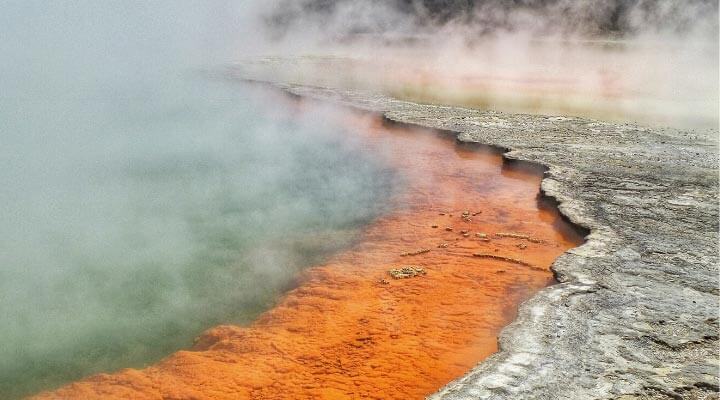Geothermal Power Plant Frequently Asked Questions

What are the differences between geothermal power plants and geothermal heat pumps?
Even though geothermal power plants and geothermal heat pumps both derive energy from the earth’s heat, they differ greatly in function, size, and scale. The former produces electricity, and the latter produces heat and AC. Power plants reach as deep as thirty thousand feet underground to supply a whole city with electricity, while heat pumps reach as deep as a few hundred feet to supply heat and AC for a residence or a commercial site.
Can geothermal power plants be used to heat and cool homes as well?
Generally no, but geothermal heat pumps can! Geothermal power plants provide renewable electricity, while geothermal heat pumps provide renewable heating and cooling.
One exception to this rule is if your home heating and AC is produced by electricity, and this electricity happens to originate from a geothermal power plant. In this case, geothermal power plants can be used to heat and cool homes in a roundabout way, but this is quite rare.
What are the different types of geothermal power plants?
There are four types of geothermal power plants: dry steam, flash steam, binary cycle, and enhanced geothermal systems (EGS). All four types of geothermal power plants produce electricity by using underground steam or hot water to turn generator turbines.
Dry steam power plants
These are the simplest of the geothermal power plants because they directly divert underground hot steam to turn turbines, which generates electricity.
Flash steam power plants
These are similar to dry steam power plants, but they require the extra step of converting hot water to steam before it can be used to turn turbines and generate electricity.
Binary cycle power plants
These are still more complex in design than flash steam power plants. In binary cycle power plants, heat is passed from the underground hot water to the power plant’s supply of water. This water is then heated into steam and passed through a turbine to generate electricity.
Enhanced geothermal systems (EGS)
An EGS is the most complex and expensive type of geothermal power plant to build. It is the only geothermal power plant that is not built over seismic or volcanic sites. This means that EGS power plants can be constructed virtually anywhere, but not without great expense in planning and construction.
That’s because even if underground steam isn’t a natural occurrence, heat can still be found in underground rock at any given location. To extract this heat, water is injected into the ground to create subsurface fractures, which is difficult and expensive to coordinate. These subsurface fractures then carry underground heat up to the surface and help to create pathways for further hot water or steam to escape. Finally, the energy from this extracted hot water or steam can be used to turn turbines and generate electricity.
How much does constructing a geothermal power plant cost? How much does operating a geothermal power plant cost?
The initial cost of geothermal power plant construction is high, but operational costs soon become relatively low. This means that, even though geothermal energy becomes financially worthwhile in the end, the cost of power plant construction may put geothermal energy out of the question.
Where are geothermal power plants located?
Geothermal power plant locations are restricted by geological features: they must be built at sites of volcanic or seismic activity, such as hot springs, geysers, and volcanoes. However, geothermal isn’t just limited to Iceland! In fact, the largest geothermal power plant complex in the world is actually located in the United States, close to San Francisco.
How much power can geothermal power plants produce?
Geothermal power plants produce about 0.4% of the United States’ overall electricity output, amounting to 16.7 kWh in 2018. However, geothermal is largely still an untapped resource, and future power plants have the potential to produce much more renewable energy than at present.
Are geothermal power plants a source of renewable energy? How do they compare to other renewable energy sources?
Yes! Geothermal power plants are a viable and renewable alternative to fossil fuel power plants, which need to burn oil or coal to generate electricity.
Geothermal is even more reliable than other renewables like solar and wind energy, because it can consistently produce energy output 24/7, regardless of weather conditions or seasonal changes. However, geothermal is less scalable and convenient than other renewable energies. For example, solar energy can range from a single solar panel to an expansive solar farm, but geothermal power plants are always large, expensive, and need to be built over regions with underground reservoirs of hot steam or water.
What are the advantages of geothermal power?
Some advantages of geothermal power include its sustainability and consistency. Geothermal energy is renewable, so it’s both more environmentally friendly and less susceptible to natural resource wars than fossil fuels are. Geothermal can consistently produce energy output 24/7, regardless of weather conditions or seasonal changes.
What are the disadvantages of geothermal power?
The disadvantages of geothermal power are the geographic limitations and high costs associated with power plant construction. These need to be built over regions with underground reservoirs of hot steam or water. Though it’s technically possible to engineer enhanced geothermal systems (EGS) in unsuitable environments, it’s highly impractical to do so. EGS requires extensive space, planning, construction, government oversight, and capital, and can only be accomplished by federal or state governments and corporations.
- Determining the Appropriate Length of a Geothermal Borehole
- Thinking About Adding Central AC? Read About Geothermal First.
- Dandelion Energy Celebrates New Tax Credit for New York Homeowners Who Install Geothermal Systems
- Geothermal Pros & Cons: Is Geothermal Right For You?
- All You Need to Know About Home Geothermal Heating & Cooling


